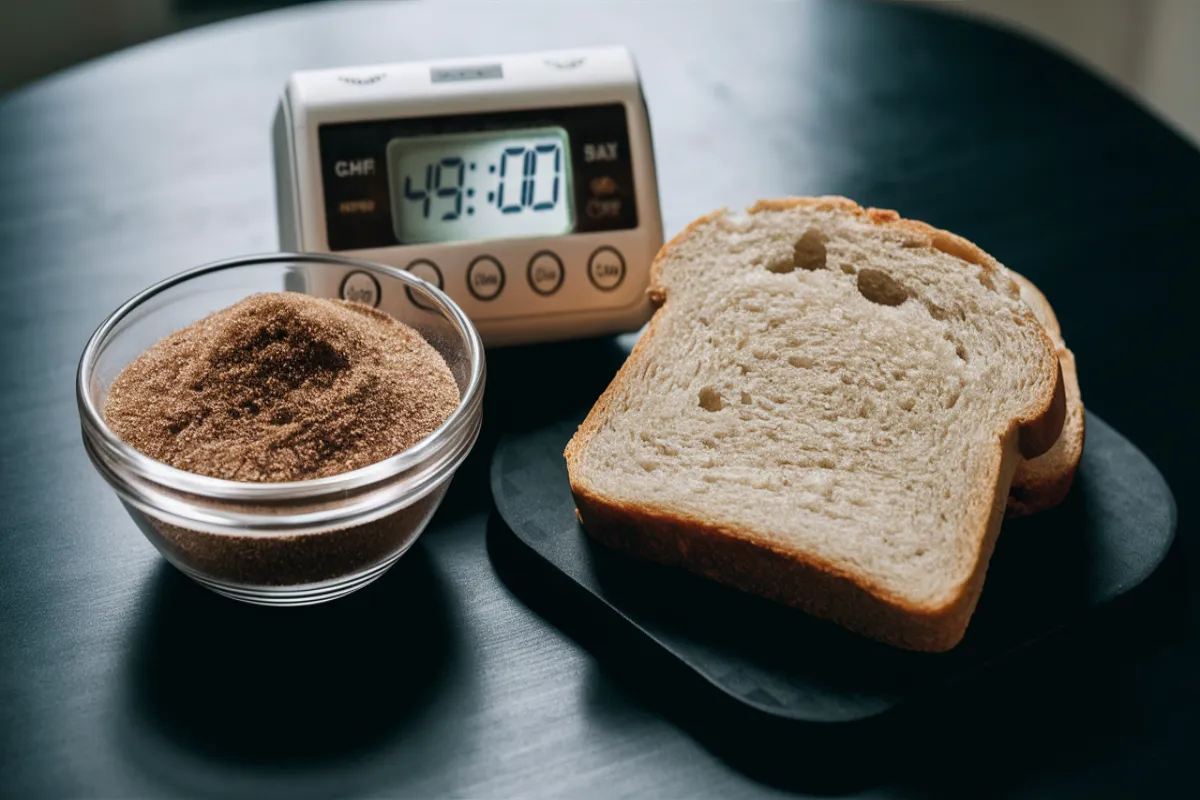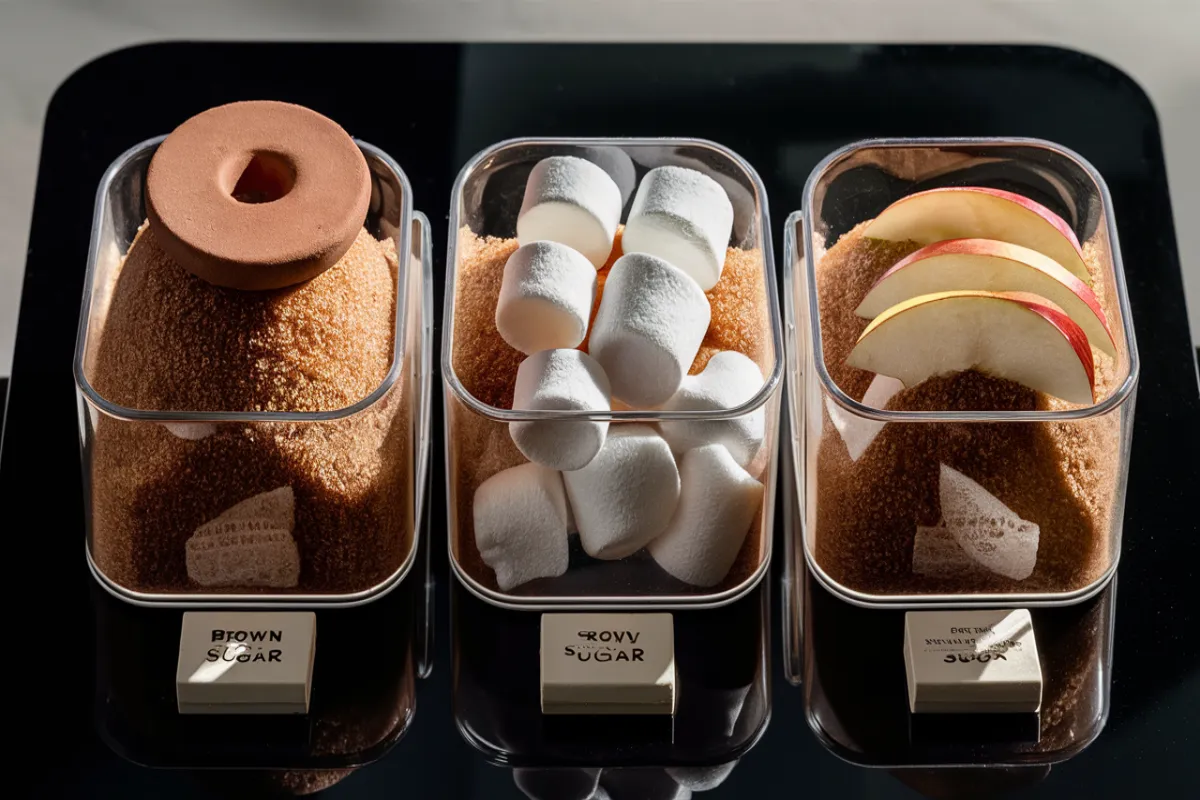The brown sugar bread trick is a simple yet effective method to keep brown sugar soft and usable. This method involves placing a slice of bread in a container with brown sugar to maintain the sugar’s moisture content. But how long do you leave bread in brown sugar for optimal results? Understanding the timing and technique can ensure that your brown sugar stays soft and ready to use. In this article, we’ll explore how long to leave bread in brown sugar, how the process works, and the best practices to maintain your brown sugar’s texture.
1. Understanding the Bread and Brown Sugar Trick
1.1 The Purpose of Using Bread
The primary purpose of placing bread in brown sugar is to keep the sugar soft. Over time, brown sugar tends to harden as it loses moisture. When you add a slice of bread to the container, the moisture from the bread transfers to the sugar. This exchange keeps the sugar from clumping together and becoming hard. The bread acts as a moisture regulator, ensuring the sugar stays in the perfect condition.
1.2 How the Process Works
The process works through a simple moisture exchange. Bread contains a higher moisture content than brown sugar. When you place the bread in a container with brown sugar, the moisture from the bread is absorbed by the sugar. At the same time, the bread absorbs any excess moisture from the air, balancing the humidity inside the container. This mutual exchange maintains the sugar’s softness.
Check this to know how to grow Potatoes in Containers
1.3 Benefits of the Bread Trick
Using bread to keep brown sugar soft has several benefits. First, it helps prevent waste by extending the usability of brown sugar. Second, it eliminates the frustration of dealing with hard, clumped sugar that’s difficult to measure or mix. Additionally, this method is cost-effective and requires no special equipment. Bread is readily available and easy to replace when necessary.
2. Timing: How Long to Leave Bread in Brown Sugar

2.1 Initial Softening Period
When you first notice that your brown sugar is hardening, place a slice of bread in the container. Leave the bread in the brown sugar for 24 to 48 hours to allow the moisture transfer process to take effect. This period is usually enough to soften the sugar, making it easy to scoop and use. If the sugar is still slightly hard after 48 hours, leave the bread in for another day or two.
2.2 Long-Term Maintenance
Once the brown sugar has softened, you can leave the bread in the container for longer periods to maintain the sugar’s texture. However, you should replace the bread every one to two weeks. Over time, the bread will lose its moisture and become stale. Regularly replacing the bread ensures that the sugar continues to absorb moisture and remains soft.
2.3 Signs It’s Time to Replace the Bread
You should replace the bread when it becomes dry or stale. Dry bread will no longer release moisture into the sugar, making it ineffective. If you notice the brown sugar starting to harden again, it’s a clear sign that the bread needs to be replaced. Fresh bread will continue to regulate the moisture and keep the sugar soft.
3. Factors Influencing Timing
3.1 Humidity Levels
Humidity levels in your environment can affect how long you leave bread in brown sugar. In humid climates, the sugar may absorb moisture from the air more quickly, reducing the need for bread. Conversely, in dry climates, the bread may dry out faster, requiring more frequent replacements. Monitoring the humidity in your kitchen helps you adjust the timing accordingly.
3.2 Container Type
The type of container you use also influences how long to leave bread in brown sugar. An airtight container is ideal because it helps maintain the right moisture balance. In a non-airtight container, moisture may escape, causing the sugar to harden more quickly. If using a non-airtight container, you may need to replace the bread more often.
3.3 Bread Type and Freshness
The type and freshness of the bread you use can impact the timing as well. Fresh, soft bread releases more moisture than stale bread. White bread is commonly used because it has a neutral flavor and high moisture content. However, any type of bread can work as long as it is fresh. If the bread is too dry, it won’t be effective in keeping the sugar soft.
4. Troubleshooting Common Issues
4.1 Bread Not Softening the Sugar
If the bread isn’t softening the sugar, consider the following factors. First, check if the bread is fresh enough to release moisture. If it’s stale, replace it with a fresh slice. Also, ensure that the container is airtight. If the container isn’t sealed properly, the moisture may escape before it can soften the sugar. Additionally, check the environment’s humidity levels and adjust accordingly.
4.2 Bread Becoming Moldy
In some cases, the bread may become moldy if left in the container for too long. This issue can occur in highly humid environments where moisture accumulates quickly. To prevent mold, replace the bread every week or sooner if you notice excess moisture in the container. If mold appears, remove the bread and sugar immediately, clean the container thoroughly, and start with fresh ingredients.
4.3 Sugar Becoming Too Moist or Sticky
If the brown sugar becomes too moist or sticky, you may be using too much bread or leaving it in for too long. Try using a smaller piece of bread or leaving it in the sugar for a shorter period. Additionally, ensure the container is airtight to prevent external moisture from affecting the sugar. Adjusting these factors helps maintain the sugar’s ideal texture.
5. Alternative Methods to Keep Brown Sugar Soft

5.1 Using a Terra Cotta Sugar Saver
A terra cotta sugar saver is a popular alternative to using bread. These small, clay discs are soaked in water and then placed in the container with brown sugar. The terra cotta releases moisture slowly, keeping the sugar soft without the need for frequent replacements. This method is reusable and easy to maintain, making it a convenient option for long-term storage.
5.2 Storing Brown Sugar with Marshmallows
Marshmallows can also help keep brown sugar soft. Like bread, marshmallows contain moisture that is gradually released into the sugar. Place a few marshmallows in the container with the brown sugar to maintain its softness. This method is effective and adds a sweet touch to your storage solution.
5.3 Using Apple Slices
Apple slices can serve as a moisture source for brown sugar, similar to bread. The natural moisture in apples is absorbed by the sugar, keeping it soft. However, apple slices may impart a slight apple flavor to the sugar, so this method is best used in recipes where the flavor complements the dish. Replace the apple slices regularly to prevent spoilage.
6. Maintaining Brown Sugar Without Bread
6.1 Storing in an Airtight Container
Storing brown sugar in an airtight container is the most effective way to maintain its softness without using bread. An airtight container prevents moisture from escaping, keeping the sugar soft and easy to use. If you notice the sugar starting to harden, consider adding a moisture source like bread, a sugar saver, or a marshmallow.
6.2 Freezing Brown Sugar
Freezing brown sugar is another method to maintain its softness. Place the sugar in a freezer-safe bag or container and store it in the freezer. When ready to use, let the sugar thaw at room temperature. Freezing prevents the sugar from hardening and keeps it fresh for longer periods. This method is especially useful for long-term storage.
6.3 Regularly Checking and Fluffing the Sugar
Regularly checking and fluffing the brown sugar helps prevent clumping and hardening. Use a fork or spoon to break up any clumps and aerate the sugar. This simple step ensures that the sugar remains loose and easy to measure. Regular maintenance can extend the life of your brown sugar and reduce the need for moisture sources like bread.
7. Practical Tips for Using the Bread Trick
7.1 Choosing the Right Bread
Choose a soft, fresh slice of bread for the best results. White bread is the most common choice because it has a neutral flavor and high moisture content. Avoid using dense or flavored breads, as they may not release moisture as effectively and could impart unwanted flavors to the sugar.
7.2 Using the Correct Amount of Bread
Use only a small slice of bread, especially if you have a small container of brown sugar. Too much bread can release excess moisture, making the sugar sticky. A smaller piece ensures the right amount of moisture is transferred without overdoing it. If you have a large container of sugar, consider using two small pieces of bread placed on opposite sides of the container.
7.3 Replacing the Bread Regularly
Regularly replacing the bread is key to maintaining the sugar’s softness. Replace the bread every one to two weeks, or sooner if it becomes dry or stale. Keeping the bread fresh ensures that the sugar continues to absorb moisture and remain soft.
8. Frequently Asked Questions
8.1 How Long Should I Leave Bread in Brown Sugar?
Leave the bread in brown sugar for 24 to 48 hours initially to soften the sugar. After that, you can leave it in for longer periods to maintain the softness, but replace the bread every one to two weeks.
8.2 What Happens If I Leave the Bread in for Too Long?
If you leave the bread in for too long, it may dry out or become moldy. Dry bread will no longer be effective in softening the sugar, and moldy bread can contaminate the sugar. Regularly replace the bread to avoid these issues.
8.3 Can I Use Any Type of Bread?
You can use any type of bread, but white bread is recommended due to its neutral flavor and high moisture content. Avoid using dense or flavored breads, as they may not release moisture as effectively and could alter the sugar’s taste.
8.4 Does the Bread Trick Work in All Climates?
The bread trick works in most climates, but you may need to adjust the timing based on humidity levels. In humid environments, the sugar may absorb moisture more quickly, reducing the need for bread. In dry climates, the bread may dry out faster, requiring more frequent replacements.
8.5 Can I Use the Bread Trick with Other Sugars?
The bread trick is most effective with brown sugar, but it can also be used with other types of sugar that tend to harden, such as powdered sugar. However, white granulated sugar does not usually require this method, as it does not harden in the same way.
Conclusion: How Long to Leave Bread in Brown Sugar
Leaving bread in brown sugar for 24 to 48 hours initially will soften the sugar, making it easier to use. For long-term maintenance, you can leave the bread in for one to two weeks, replacing it regularly to ensure continued effectiveness. Factors such as humidity, container type, and bread freshness can influence the timing, so adjust accordingly. By understanding how long to leave bread in brown sugar and following these best practices, you can keep your brown sugar soft and ready for use at all times.
Leave a Reply